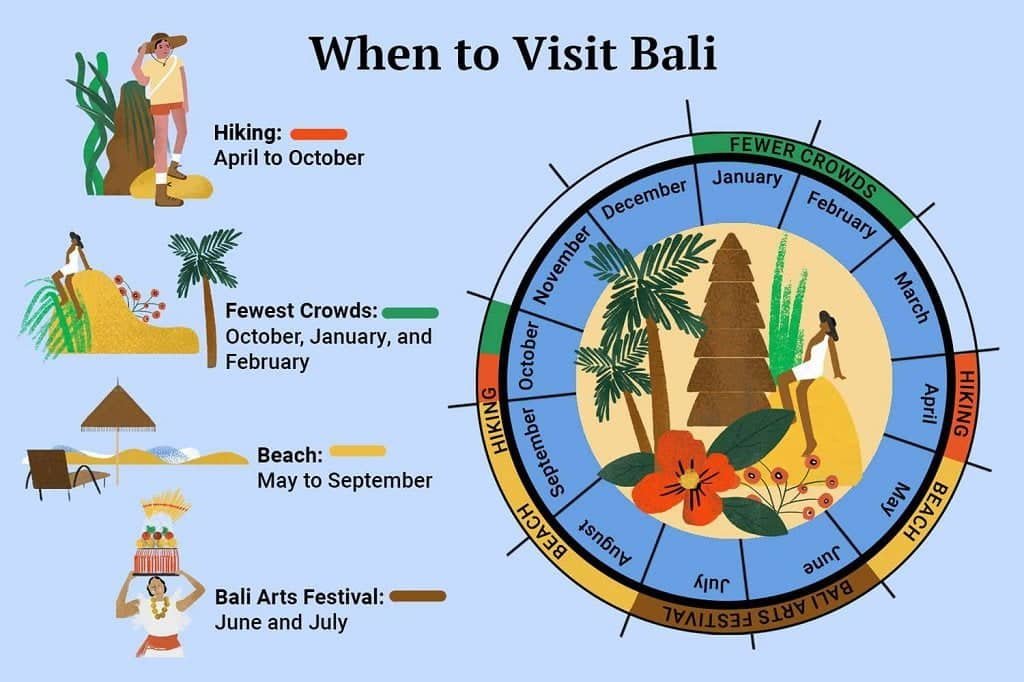Are you planning a trip to Bali? Do you know when the best time to visit is? While Bali is a beautiful and popular tourist destination, it’s important to know when to go to make the most of your trip. In this article, I’ll discuss the worst time to travel to Bali and what you need to know to avoid any unpleasant surprises.
By the end of this article, you’ll know when to avoid traveling to Bali to ensure you have the best possible experience. Whether you’re planning a relaxing beach vacation or an adventurous trip exploring the island, knowing when to go is key. So, let’s dive in and find out when you should avoid traveling to Bali.
Where is Bali?

Bali is an island located in Indonesia, a Southeast Asian country known for its beautiful beaches, and volcanoes. Bali is just one of the thousands of islands that make up Indonesia, but it is one of the most popular tourist destinations in the country, attracting millions of visitors each year.
The Island of Bali is situated between Java and Lombok, two other major islands in Indonesia. Bali is a relatively small island, covering an area of just over 2,200 square miles. Despite its small size, Bali is home to a diverse range of landscapes, from lush rice paddies and tropical forests to sandy beaches and turquoise waters.
If you’re planning a trip to Bali, it’s important to keep in mind that the island is located in a tropical climate. This means that temperatures are warm and humid year-round, with the rainy season occurring from November to March. Despite the rainy season, Bali is a popular destination year-round due to its warm temperatures and beautiful scenery.
What is The Worst Time To Visit Bali?
The worst time to travel to Bali is during the rainy season, which runs from November through April. The rainy season is the wettest time of the year, making it the worst time to visit Bali.
Bali during the rainy season can be unpredictable, with heavy downpours and flooding. The humidity is also high, making it uncomfortable to be outside for long periods. January and February are the wettest months of the year, making it the worst time to travel to Bali.
Visiting Bali during the rainy season is the worst time to go because many outdoor activities are impossible due to the rain. The rain can also affect the beaches, making them less enjoyable.
When is The Best Time to Visit Bali?

The best time to visit Bali is during the dry season, which runs from May to October. During these months, you can expect clear blue skies and warm temperatures, perfect for outdoor activities such as hiking, surfing, and sunbathing. The humidity is also lower during this time, making it more comfortable to explore the island.
June through August are the best months to visit Bali if you want to go water sports because that’s when the waves are at their biggest and the water is the clearest. This is the best time of year to go diving and snorkeling because of the great visibility.
Here is a table showing the best months to visit Bali and the activities you can do during those months:
| Month | Best Time to Visit | Activities |
| May | Good | Surfing, sunbathing, hiking |
| June | Best | Surfing, snorkeling, diving |
| July | Best | Surfing, snorkeling, diving |
| August | Best | Surfing, snorkeling, diving |
| September | Good | Surfing, sunbathing, hiking |
| October | Good | Surfing, sunbathing, hiking |
Best Times to Visit Bali for Smaller Crowds
The ideal time to visit Bali is during the shoulder or low season if you want to avoid the crowds. The shoulder seasons are April through June and September through November, and the low season is from January to March. Bali is less crowded during these hours, so you can enjoy the attractions without having to deal with long lineups or traffic.
In addition to smaller crowds, visiting Bali during the low or shoulder season can save you money. Hotels and resorts often offer discounted rates during these times, and you can also find cheaper flights. Keep in mind that the weather during the low season can be unpredictable, with occasional rain showers, but you can still enjoy sunny days.
Best Times to Visit Bali for Good Weather
The dry season is the ideal time to visit Bali if you’re looking for sunny weather. In Bali, the dry season normally lasts from May through September, with the peak month being June through August. This is the ideal time to visit Bali’s stunning beaches and outdoor attractions because you can expect clear skies and low humidity.
During Bali’s dry season, the weather is typically predictable, with little to no rain. For tourists hoping to escape the rain and take advantage of Bali’s best weather, this is wonderful news. If you want to engage in water sports like diving, snorkeling, or surfing, the dry season is the ideal time to visit Bali.
If you’re planning to visit Bali during the dry season, it’s important to book your accommodations and activities in advance. This is because the dry season is the busiest time of year in Bali, and hotels and activities can fill up quickly.
Best Time for Exploring the Outdoors in Bali
The best time to visit Bali if you want to engage in outdoor activities is during the dry season, which lasts from April to October. The weather is dry and sunny during this period, which is ideal for taking in Bali’s natural splendor.
One of the best ways to explore Bali is by hiking. Central Bali has several stunning hiking trails, including Mount Batur and Mount Agung. These hikes offer breathtaking views of Bali’s lush forests, rice paddies, and volcanoes. The best time to hike is during the dry season, as the trails can be slippery and dangerous during the rainy season.
Another popular outdoor activity in Bali is surfing. Bali is known for its world-class surf breaks; the best time to surf is during the dry season. The waves are bigger and more consistent during this time, making it perfect for beginners and experienced surfers.
Beautiful beaches can also be found in Bali if you’re searching for something more leisurely. The water is calm and clear, making it ideal for swimming and snorkeling, and the beaches are less crowded during the dry season.
What is The Cheapest Month to Travel to Bali?
The rainy season, which runs from November to March, is the most affordable time to visit Bali. Bali sees a lot of rainfall and high humidity during these months. Also, now is the ideal time to find the lowest prices on travel, lodging, and activities.
You should think about visiting Bali during the rainy season if you’re on a tight budget and want to save costs. Because the prices are lower, you can save money on activities and find fantastic deals on travel and lodging.
Keep in mind that the weather during the rainy season is not ideal for outdoor activities, such as surfing and sunbathing. If you’re planning to visit Bali during the rainy season, bring a raincoat and waterproof shoes.
What is Rainy Season in Bali?
It’s crucial to know when Bali’s rainy season falls so that you can make appropriate travel plans if you intend to visit. November through March is usually when Bali experiences its rainy season, also referred to as the wet season. Expect a lot of rain and a lot of humidity at this time of year.
The rainy season in Bali is characterized by frequent and sudden downpours, often accompanied by thunder and lightning. The rain can be intense and last several hours, causing flooding and traffic disruptions. This is especially true in the low-lying areas of the island.
It’s worth noting that the rainy season in Bali doesn’t mean that it rains all day, every day. It’s common for there to be periods of sunshine and clear skies in between the rain showers. However, the humidity levels can be quite high, making it feel hotter than it is.
If you’re planning to visit Bali during the rainy season, it’s important to pack accordingly. Be sure to bring waterproof clothing, such as a rain jacket or poncho, and water-resistant shoes. You may also want to bring an umbrella or rain hat to protect yourself from the rain.
High And Low Season For Bali

When making travel plans to Bali, it’s critical to understand the distinction between the high and low seasons. July through August is Bali’s high season and peak season. Bali is packed with visitors at this time of year, and costs are high. The rainy season, or low season, runs from November through March. Bali has a lot of rain during this time of year, and some tourist attractions might be closed.
The best time to visit Bali is during the dry season, from April to October. During this time, the weather is pleasant, and there is less rainfall. May, June, and September are the best months to visit Bali before the crowds arrive. July and August are the peak months for tourism, so it is recommended to book well in advance for hotels and activities.
If you are looking for a budget-friendly trip, the low season is the best time to visit Bali. During this time, accommodation and tour prices are lower, and you can avoid the crowds. However, you should be prepared for heavy rainfall and some tourist attractions may be closed.
How Do You Improve Your Travel Experience During The Worst Time Visiting Bali
Even if your trip to Bali is scheduled during the off-peak season, you can still have a great time by adhering to a few basic advice. Here are some tips to make the most of your trip even if you’re visiting Bali at the worst time of year:
- Plan ahead: Before you go, research the weather and tourist seasons in Bali. Avoid the peak tourist season, which is from July to August, and the rainy season, which is from October to April. Instead, plan your trip during the shoulder season from May to June and September. The weather is still good, and the crowds are smaller during this time.
- Pack smart: Make sure to pack clothes and gear appropriate for the weather conditions when you visit. Bring a raincoat or umbrella if you are visiting during the rainy season. Bring light and breathable clothing if you are visiting during the hot season.
- Be flexible: If the weather turns bad or the crowds are too much to handle, be flexible with your plans. Have a backup plan in case your original plan falls through. You can also consider visiting less popular attractions or off-the-beaten-path destinations.
- Stay in the right location: Choose a less crowded and more peaceful location. Avoid staying in the tourist hotspots, such as Kuta or Seminyak, during peak season. Instead, consider staying in quieter areas, such as Ubud or Canggu.
- Book in advance: If you are visiting Bali during peak season, book your flights, accommodations, and activities in advance. This will help you avoid the crowds and get the best deals.
Following these tips can improve your travel experience during the worst time visiting Bali. Remember to plan ahead, pack smart, be flexible, stay in the right location, and book in advance to make the most of your trip.
The Bali By Month: Climate & Activities
Knowing the ideal and worst times to visit Bali is crucial if you’re planning a trip there. Two distinct seasons—the dry and the rainy—are associated with Bali’s tropical climate. October through March is the rainy season, and April through September is the dry season.
Here’s a month-by-month breakdown of Bali’s climate and activities:
- January: January is one of the wettest months in Bali. Expect high humidity and frequent rain showers. While it may not be the best time to visit Bali, you can still enjoy indoor activities such as cooking classes, spa treatments, and museum visits.
- February: February is still part of the rainy season in Bali. The weather is warm and humid, with occasional rain showers. You can still enjoy indoor activities such as art galleries, shopping, and cultural performances.
- March: March marks the end of the rainy season in Bali. The weather is still warm and humid, but there are fewer rain showers. March is a great time to visit Bali if you want to avoid the crowds and enjoy outdoor activities such as hiking, surfing, and beach hopping.
- April: April is the start of the dry season in Bali. The weather is warm and sunny, with low humidity. April is a great time to visit Bali if you want to enjoy outdoor activities such as snorkeling, diving, and island hopping.
- May: May is one of the best months to visit Bali. The weather is warm and sunny, with low humidity. May is a great time to enjoy outdoor activities such as hiking, cycling, and beach hopping.
- June: June is one of the busiest months in Bali. The weather is warm and sunny, with low humidity. June is a great time to enjoy outdoor activities such as surfing, diving, and beach parties.
- July: July is one of the peak months in Bali. The weather is warm and sunny, with low humidity. July is a great time to enjoy outdoor activities such as hiking, cycling, and beach hopping.
- August: August is one of the peak months in Bali. The weather is warm and sunny, with low humidity. August is a great time to enjoy outdoor activities such as surfing, diving, and beach parties.
- September: September marks the end of the dry season in Bali. The weather is warm and sunny, with low humidity. September is a great time to visit Bali if you want to avoid the crowds and enjoy outdoor activities such as hiking, cycling, and beach hopping.
- October: October marks the start of the rainy season in Bali. Expect high humidity and frequent rain showers. While it may not be the best time to visit Bali, you can still enjoy indoor activities such as cooking classes, spa treatments, and museum visits.
- November: November is one of the wettest months in Bali. Expect high humidity and frequent rain showers. While it may not be the best time to visit Bali, you can still enjoy indoor activities such as art galleries, and shopping.
- December: December is still part of the rainy season in Bali. The weather is warm and humid, with occasional rain showers. You can still enjoy indoor activities such as cooking classes, spa treatments, and museum visits.
Where To Stay In Bali?
If you’re planning a Bali vacation, one of the most important decisions you’ll make is where to stay in Bali. Bali brings together a diverse range of experiences, from the bustling nightlife of Kuta to the tranquil rice paddies of Ubud. Bali is a tropical paradise; where you decide to stay will depend on your budget, preferences, and what you want to see and do.
Consider booking a stay in Seminyak or Nusa Dua if you’re looking for a tranquil beach getaway. These regions of Bali are well known for their opulent resorts, spotless shorelines, and tranquil waters. Families and couples will love Nusa Dua, while young tourists and party animals will prefer Seminyak.
If you’re on a budget, consider staying in Kuta or Legian. These parts of Bali are popular with backpackers and offer a range of affordable accommodation options, from hostels to budget hotels. Kuta is also known for its lively nightlife, making it a great choice for young travelers.
No matter where you decide to stay in Bali, be sure to research and book your accommodation well in advance. Bali is a popular destination, and the best places to stay tend to book up quickly.
Frequently Asked Questions (FAQs)
What are the peak rainy months in Bali that travelers should avoid?
The peak rainy months in Bali are typically from November to March. The island experiences heavy rainfall, high humidity, and occasional thunderstorms during this period. Therefore, if you want to avoid getting caught in the rain and enjoy outdoor activities, it is best to avoid visiting Bali during these months.
During which season does Bali typically experience the least favorable weather conditions?
Bali experiences the least favorable weather conditions during the wet season, typically from October to April. The island experiences heavy rainfall, high humidity, and occasional thunderstorms during this period. Bali’s dry season, which runs from May to September, is generally considered the best time to visit the island.
What months are considered the high season in Bali, when it might be overcrowded and less enjoyable?
The high season in Bali typically runs from July to August, during the summer holidays in the northern hemisphere, and from December to January, during the Christmas and New Year holidays. During these months, Bali can be overcrowded, and prices for accommodation and activities can be higher than usual.
Are there specific times of year when Bali is known to be more expensive and less budget-friendly?
Bali is generally more expensive and less budget-friendly during the high season, which runs from July to August and December to January. During these months, prices for accommodation and activities tend to be higher than usual.
What period is prone to over-tourism in Bali, potentially impacting the quality of a vacation?
Bali is prone to over-tourism during the high season, which runs from July to August and December to January. During these months, Bali can be overcrowded, and popular tourist attractions can be busy and less enjoyable. It is best to avoid visiting Bali during these months to avoid the crowds and enjoy a more peaceful vacation.
Which months should honeymooners steer clear of to avoid Bali’s less romantic weather conditions?
Honeymooners should avoid Bali’s peak rainy months, which typically run from November to March. During this period, the island experiences heavy rainfall, high humidity, and occasional thunderstorms, which can make it less romantic and enjoyable.
Conclusion
The worst time to travel to Bali is during the rainy season, which lasts from October to April. Heavy rainfall can cause flooding and landslides during this time, making transportation difficult and dangerous. Additionally, the humidity can be unbearable, and the beaches may be littered with debris.
It’s crucial to make sensible travel plans and, if at all possible, stay away from the wet season. Think about going to Bali in May through September, which is considered the dry season. The beaches are lovely and clean during this time of year, and the weather is more agreeable.
Remember that Bali is a popular tourist destination that can get crowded during peak season. If you prefer a quieter experience, consider visiting during the shoulder season.
I hope this article has provided valuable information to help you plan your trip to Bali. Don’t forget to share your experiences with us in the comments below.















